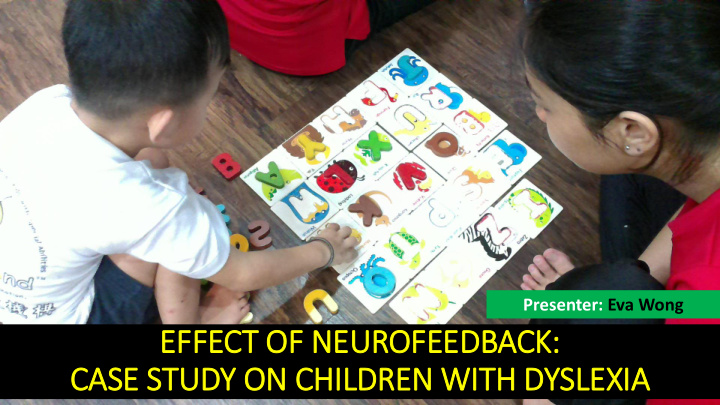



Presenter: Eva Wong EFFECT OF NEUROFEEDBACK: CASE STUDY ON CHILDREN WIT ITH DYSLEXIA
OBJEC OBJECTIVES OF TH TIVES OF THE P E PAPER APER Seeks to present the effectiveness of Neurofeedback as strategy to improve children with Dyslexia in word recognition
WHY? 7% Standard 2 Malays students (Gomez, 2000) • PREVALENCE RATE OF ASD • IMPLICATIONS OF THE CONDITION: PSYCHOLOGY SOCIAL BEHAVIOUR • CONDITION IN MALAYSIA
METHODOLOGY Embedded experimental design QUAL + quan Creswell, 2003
Research Design qual Quan • n= 10, DDT (Dysphoneidesia) • Age (mean): 8.4 Dyslexia • Sampling: Purposive Determination Test Burt Reading Test • Design: Pre-post • Group: Intervention (A-E), Post-positivism positivism Control (F-J) • Duration: 30 sessions
WHAT? Educational Therapy • Intervention group Educational Therapy Neurofeedback Phonetic Writing Task Task • Intervention group Educational Therapy
INTERVENTION GROUP IN Block Duration Instruction 0 - 5 minutes Toy play 1 5 - 25 minutes Phonic Task 2 25 - 55 minutes Games + Neurofeedback 3 55 – 75 minutes Writing tasks 4 Neurofeedback Protocol T6 Delta Marinus, et al (2009) F7 – C3 Alpha
CONTROL GROUP Block Duration Instruction 0 - 5 minutes Toy play 1 5 - 25 minutes Phonic Task 2 25 - 55 minutes Games 3 55 – 75 minutes Writing tasks 4
Chro. Burt Subjects FIN INDINGS: Age Pre Post A 7;4 3;9 4;3 Intervention Group In B 7;7 4;1 4;5 C 7;6 3;3 3;9 D 7;3 3;8 4;2 • Quantitative Data E 7;8 3;7 4;2 • Pre: Avg 3.67 • Post: Avg 4.08 Reading Age Pre and Post Intervention (Intervention Group) 9 8 • 11.36% (Improvement) 7 6 5 4 3 2 1 0 A B C D E Pre Post
FIN INDINGS: Burt Burt Subjects Before After Control Group F 3;1 3;3 G 3;6 3;9 H 4;1 4;4 • Quantitative Data I 3;3 3;3 J 4;0 4;7 • Pre: Avg 3.58 • Post: Avg 3.83 Reading Age Pre and Post Intervention (Control Group) 10 9 • 7.00% (Improvement) 8 7 6 5 4 3 2 1 0 F G H I J Pre Post
Fin indings: : Qualitative Data (In (Intervention Group) Dysle lexia Determination Test Pre – Intervention Post - Intervention Subjects Basal Level Ceiling Level Basal Level Ceiling Level A Pre-Primer Pre-Primer Primer Primer B Pre-Primer Pre-Primer Pre-Primer Primer C - - Pre-Primer Pre-Primer D - - Pre-Primer Pre-Primer E Pre-Primer Pre-Primer Primer Grade 1
Fin indings: : Qualitative Data (C (Control Group) Dysle lexia Determination Test Pre – Intervention Post - Intervention Subjects Basal Level Ceiling Level Basal Level Ceiling Level A - - B Primer Primer C Pre-Primer Pre-Primer D Pre-Primer Grade 1 E Pre-Primer Pre-Primer
DIS ISCUSSION • Result (intervention and control group) • Quantitative and Qualitative • Literature (Vanessa, 2014; Edelson, 2014)
Limitation • Limited number of subjects • Short intervention duration • Long term effect?
THANK YOU
Recommend
More recommend